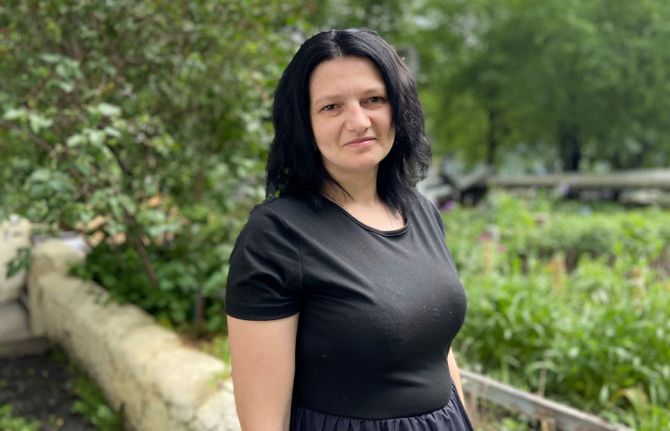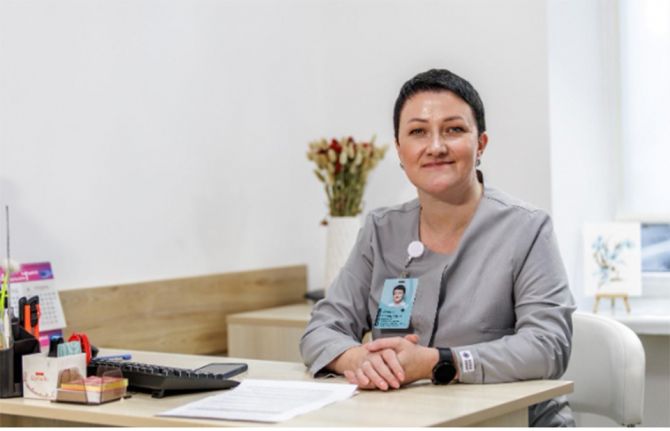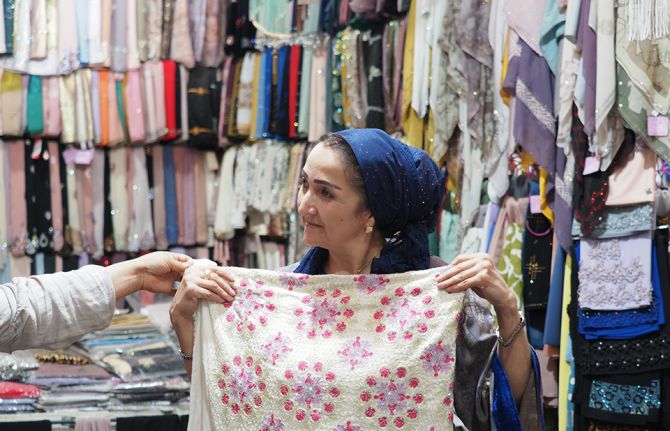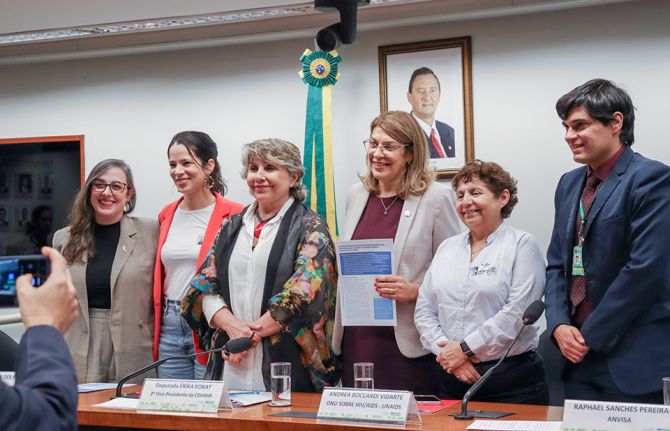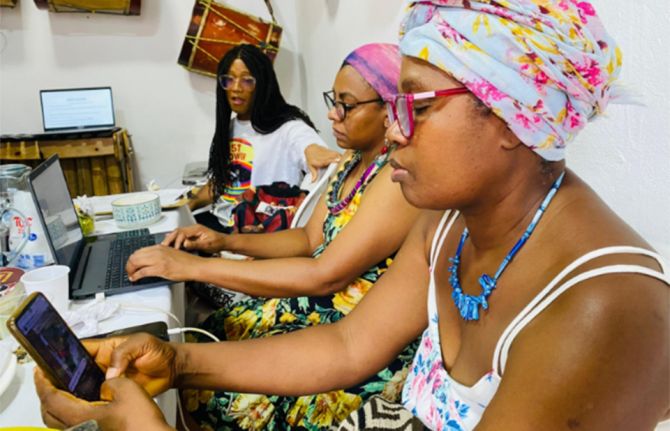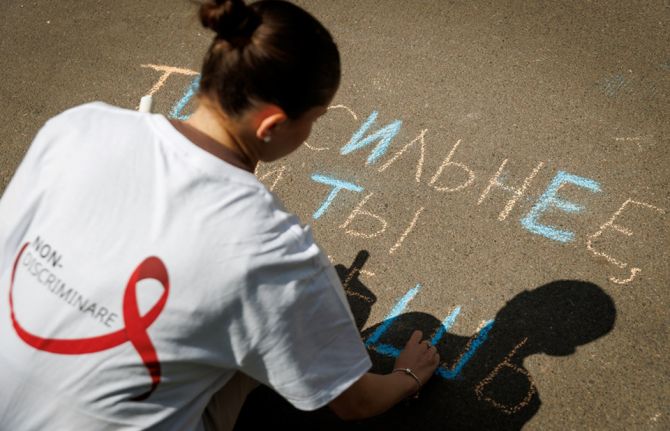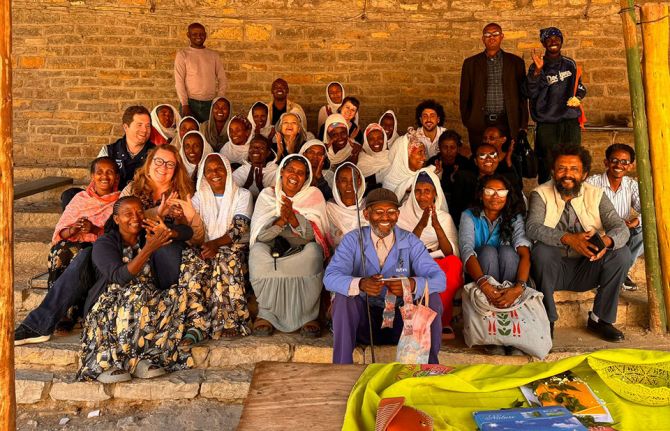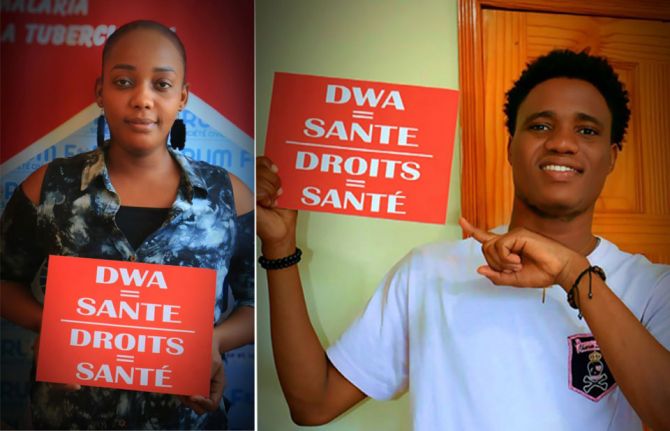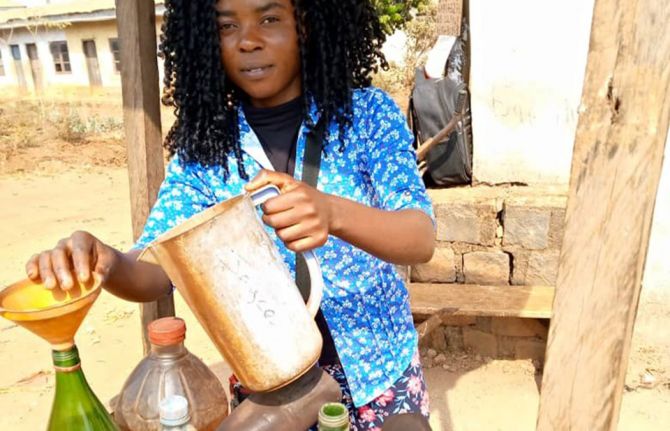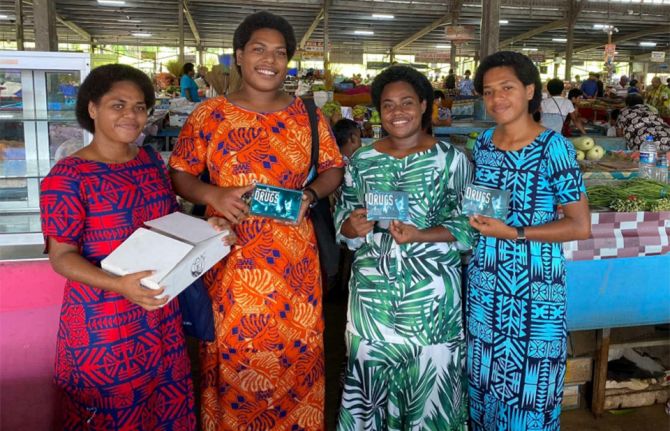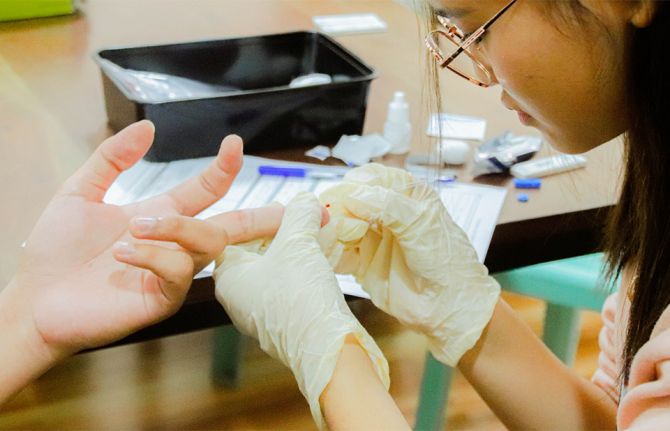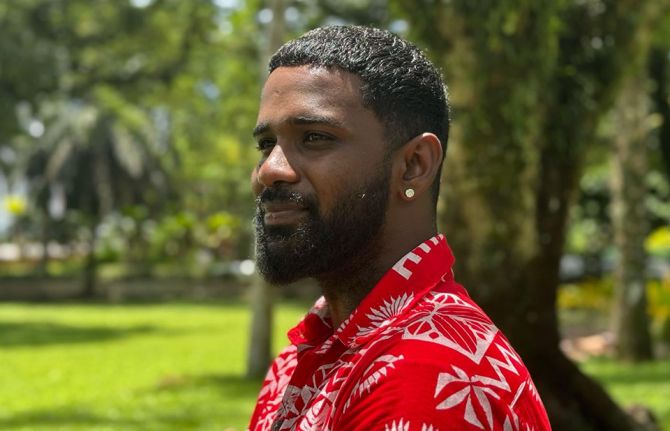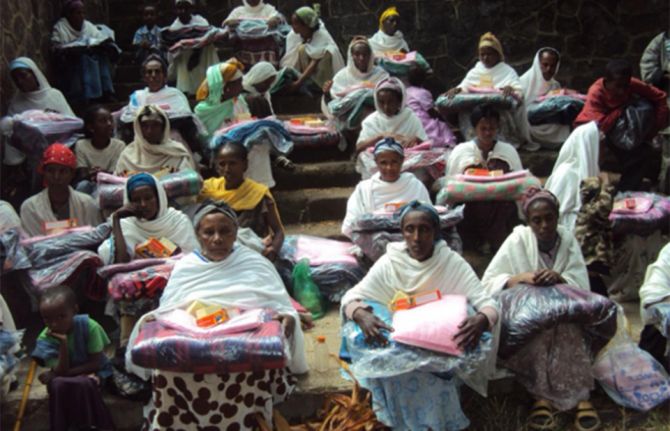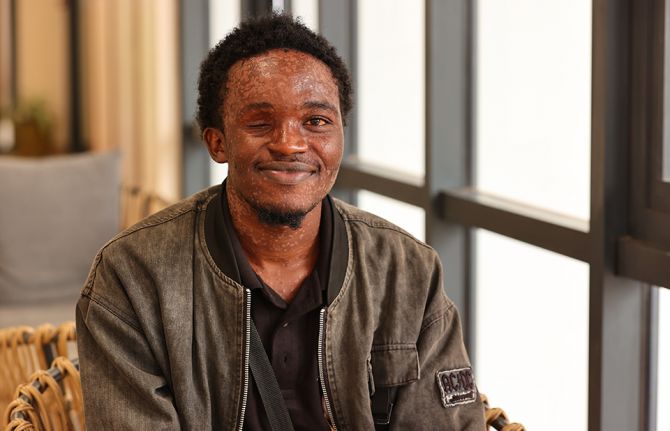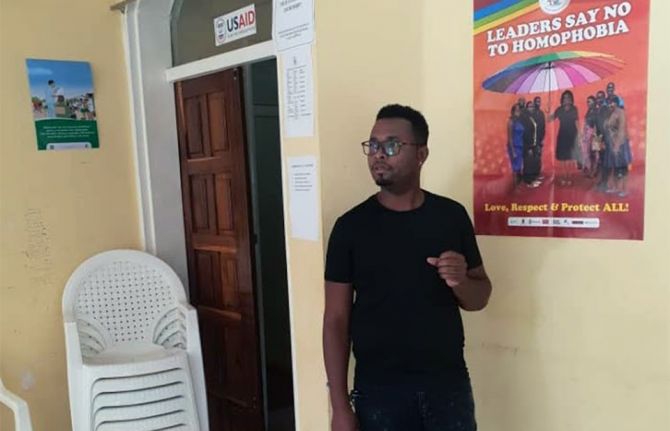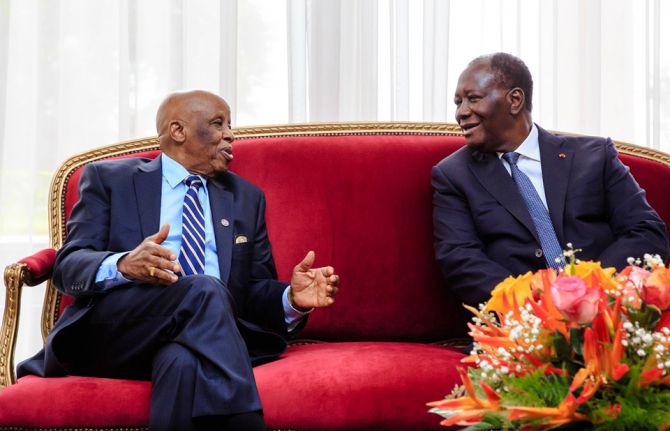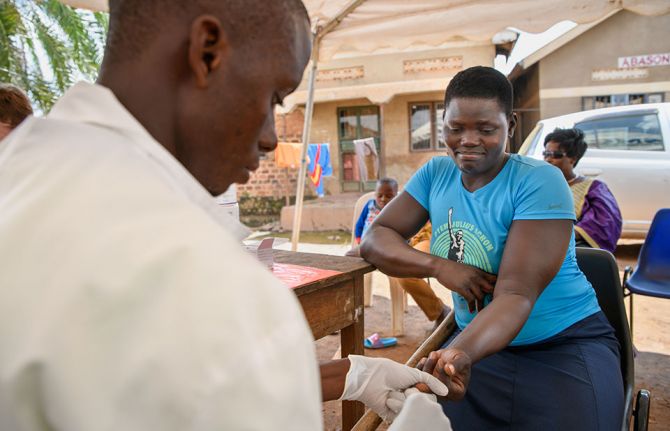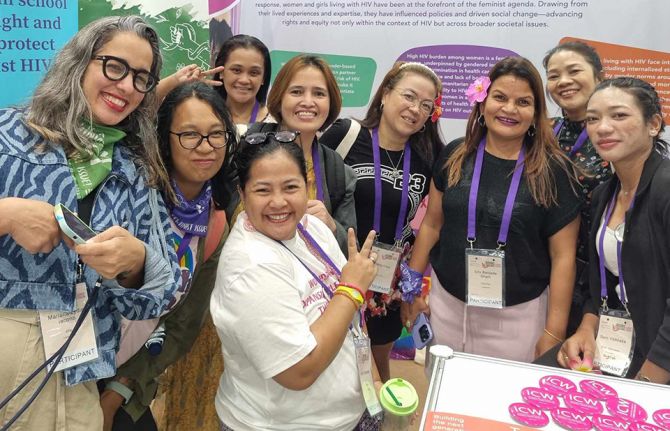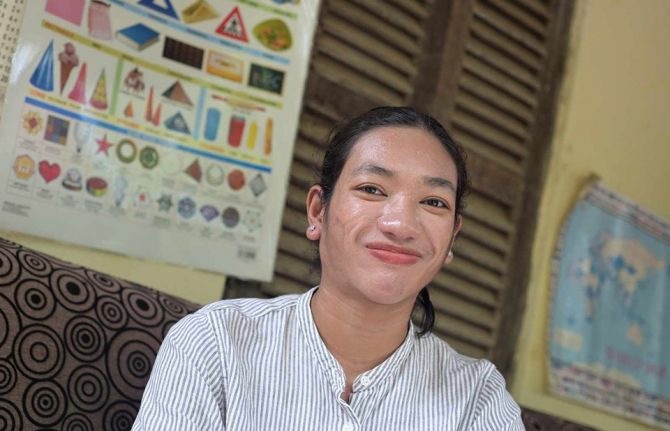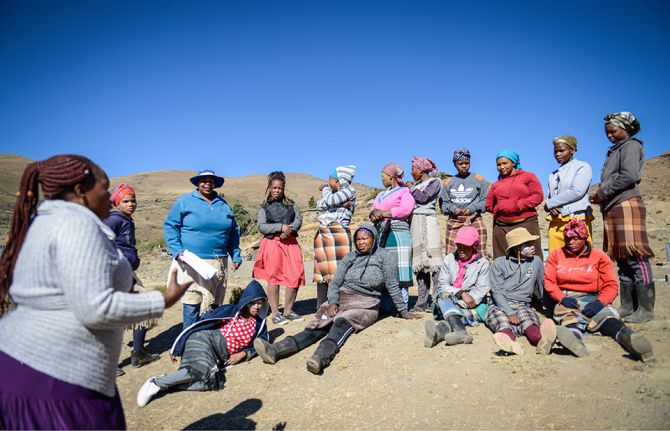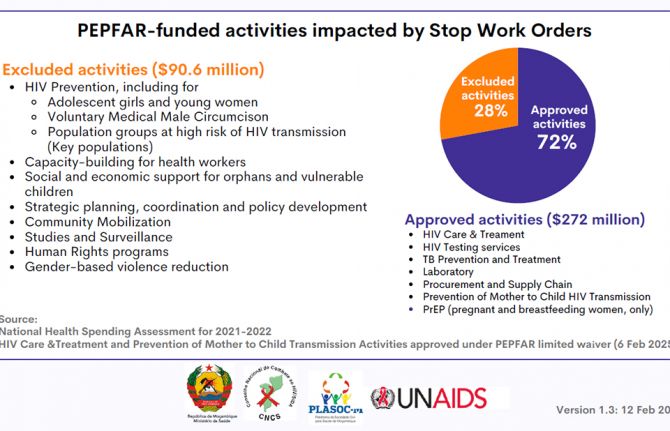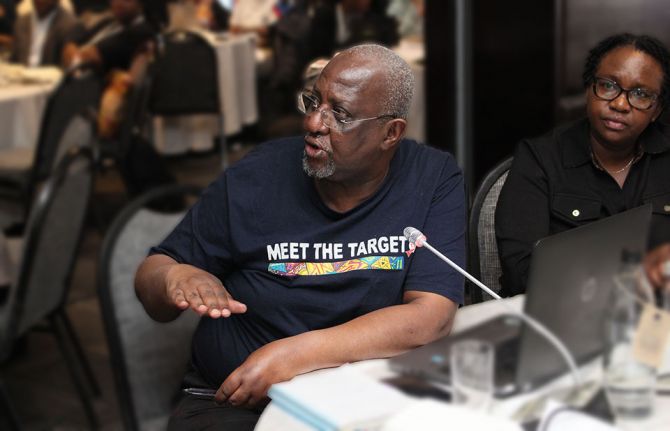
Feature Story
Artists in Russia come together to spread awareness about HIV
18 November 2009
18 November 2009 18 November 2009
Yulia Lasker, Russian singer, who purchased a tapestry at the opening of the exhibition.
Credit: UNAIDS
UNAIDS and the All-Russian Union of People Living with HIV came together for the second time to support the international project Art Against AIDS that unites well-known artists in the response to the HIV epidemic in Russia. This year, proceeds from the sale of art at the exhibition went to low-income families raising children living with HIV.
More than 30 contemporary artists, photographers, and musicians from Russia, the United States, Japan, Greece and Spain offered their work for the charitable exhibition-sale held at the Central House of Artists from 12 - 26 November 2009. Last year, funds raised during the exhibition-sale went to children living with HIV at the Vsevolozhsk Orphanage in Leningrad Oblast.
There is increasing political and financial commitment for universal access to HIV prevention, treatment and care in Russia, even in the face of a global financial crisis. The country is set to increase the number of people on antiretroviral treatment by 50,000 in 2009. Through this exhibition, artists, photographers and musicians are helping to speak openly about HIV and to draw the attention of the wider public towards this issue.

One of the art pieces sold at the launch of Art Against AIDS on the 12 of November.
Credit: UNAIDS
Earlier in October during the 3rd HIV/AIDS Conference in Eastern Europe and Central Asia, UNAIDS Executive Director Michel Sidibé said that there has been progress in the region with many countries set to achieve universal access target goals. But the UNAIDS head also noted that the AIDS epidemic continues to outpace the response as the estimated number of adults and children living with HIV in the Eastern Europe and Central Asia region has doubled since 2001.
Injecting drug use is the main mode of HIV transmission across Eastern Europe and Central Asia. HIV prevention among drug users and their sexual partners is a vital component of an evidence-informed response. Although the HIV epidemic in the Russian Federation is the largest in the region, there are rising numbers in Azerbaijan, Georgia, Kazakhstan, Kyrgyzstan, the Republic of Moldova, Tajikistan, and Uzbekistan.
Artists in Russia come together to spread awarene
Key populations:
Cosponsors:
Feature stories:
“Artists Against AIDS” help fight stigma and discrimination in Russia (17 November 2008)
All-Russian Union of People Living with HIV (09 July 2009)
“Art for AIDS” receives Keith Haring sculptures (27 November 2008)
"Stars against AIDS" in Eastern Europe (19 May 2008)
Related

Feature Story
“Just like you” video campaign against stigma and prejudice launched in Brazil
17 November 2009
17 November 2009 17 November 2009New campaign to be broadcast by television across Brazil highlights rights of students, gay men, lesbians, people living with HIV, the Afro-Brazilian population, sex workers, refugees, transsexuals and transvestites and drug users.
Equal rights and a call to Brazilian society on the issue of the discrimination experienced daily by men, women and children in the country are the messages of a powerful ”Just like you” video campaign, launched 16 November in Rio de Janeiro, by UNAIDS in partnership with other United Nations agencies with the participation of civil society and the government authorities on human rights.
Ten thirty second films were shown during the launch, films that present a panorama of the reality faced by each population covered by the campaign – school students, gay men, lesbians, people living with HIV, the Afro-Brazilians, sex workers, refugees, transsexuals and transvestites and drug users. The films will be broadcast in Portuguese on television stations throughout the country. DVDs and CDs will also be distributed to health care facilities, schools and the National Business Council on HIV. The films are also available with subtitles in English and Spanish so they can be shown internationally.
The campaign launch ceremony was followed by a press conference, at the Palácio do Itamaraty with the community leaders who recorded the campaign messages as well as UN officials from UNODC, UNAIDS, UNIFEM, UNESCO, UNHCR and UNIC. Representatives of the Special Secretariats of Human Rights and of Policies in Promotion of Racial Equality, the Ministry of Education and civil society were also present.

“Just like you, I want respect,” still from one of the videos in the “Just like you” campaigne launched in Rio de Janeiro on 16 November, 2009.
Credit: UNAIDS
Human rights visibility
“Just like you” is a campaign against stigma and prejudice, giving voice and visibility to the human rights of people often overlooked by society in Brazil. The films communicate the messages of leaders of each of the discriminated groups.
The campaign is an initiative against human rights violations and inequalities in the areas of health, education, employment, public security and everyday life. It is an opportunity to raise the awareness of Brazilian society with regard to respecting the differences that characterize each of the social groups represented in the campaign, reaffirming equal rights.
Everyday stigmas and prejudices
Data from the Brazilian Institute of Geography and Statistics reveal the racial and gender inequalities in Brazil through the disparity in average monthly income: white men earn on average R$ 1,200, considerably more than white women (R$700), twice that of black men (R$ 600), and three times that of black women (R$ 400).
The school environment is another example of resistance to diversity. A 2009 survey of 500 state schools done by Anísio Teixeira National Institute of Educational Research and Studies and Economic Research Institute Foundation, between 55% and 72% of students, teachers, head teachers and education workers showed a resistance to diversity and the greatest distance was seen in relation to homosexuals (72%).
Campaign signature
Prejudice manifests itself through discriminatory attitudes and practices, such as humiliation, aggression and unfair accusations merely because people belong to a specific social group.
The United Nations agencies in Brazil joined with a number of civil society groups for this equal rights campaign including ABGLT (Brazilian Gay, Lesbian, Bisexual, Transvestite and Transsexual Association), AMNB (Association of Black Brazilian Women), ANTRA (National Articulation of Transvestites, Transsexual and Transgender Persons), the Brazilian Movement of People Living with HIV/AIDS and the Brazilian Network of Prostitutes.
“Just like you” video campaign against stigma and
Cosponsors:
Partners:
Multimedia:
Watch the compaign
(YoiuTube.com)
Watch the compaign
(Onu-Brasil.org.br)
Contact:
UNAIDS
Naiara Garcia e Jacqueline Cortes:
Tel: (61) 3038.9220 / 9224 – 9196 9232
Related

Feature Story
Food by Prescription: A Landscape paper from GAIN
16 November 2009
16 November 2009 16 November 2009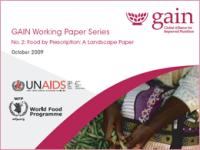
The World Summit on Food Security opens 16 November in Rome. In many parts of the world, lack of food security and poor nutrition are worsening the effects of the HIV epidemic.
Although HIV testing is increasingly available and efforts to support the nutritional needs of people living with HIV have intensified appreciably, antiretroviral therapy (ART) service providers continue to report large numbers of clients presenting with advanced disease and acute malnutrition. In some ART programmes, as many as 33 percent of all first-visit clients are unable to walk into the clinic without assistance, correlating with high rates of mortality in the first 90 days of treatment. In response, there has been a rapid proliferation of Food by Prescription (FBP) programmes, designed to ensure efficient and effective nutrition care and rehabilitation for people enrolled in HIV care and treatment programmes.
This paper from the Global Alliance for Improved Nutrition (GAIN) provides an overview of current thinking on modes of delivery and the salient issues surrounding FBP programme implementation. Its purpose is to document current thinking and experience, and identify areas of convergence and divergence. This will provide a starting point for future consultations where key issues can be elaborated and prioritized, and a plan for future action developed. Given the dearth of literature on FBP, information for this report was gathered primarily through semi-structured interviews with key informants from governments, civil society organizations, technical assistance agencies, donors and beneficiary groups.
This document reveals that, in less than a decade, a wide variety of creative FBP mechanisms and designs have emerged, catering to one or more of three core objectives. The primary emphasis of FBP programmes is on the nutritional rehabilitation and/or nutrition support of the patient to improve well-being and treatment outcomes. However, many FBP programmes have expanded this mandate to include provision of social safety nets to support treatment adherence and protect household integrity. Moreover, several FBP programmes have begun to support livelihood activities with the aim of encouraging a productive recovery and sustaining adherence. Programme designs are highly contextualized: some focus on one or two of these objectives while others aim for a comprehensive approach through partnerships and referral networks. Some programmes operate from a clinical base while others operate from an established foothold in the community, while still others have formed strategic linkages which span home, community and clinical settings.
Among all those interviewed, there is a sense of urgency driving the rapid rollout of this programming and an acknowledgement that there is much to learn about how to do it well. There is (at this point) no consensus about the optimal location of FBP programmes. There is general agreement on the use of anthropometric criteria for programme entry, but less agreement on discharge criteria. There are several different commodity options in use, with no evidence base to guide decision-making. In many settings, there is a need to more clearly differentiate between client-level nutritional rehabilitation and household-level food insecurity. There is a call for guidance and harmonization of objectives, standards and protocols.
This document was constructed according to themes, which were identified early in the process.
These included potential for integration and standardization; allocation of resources; human resource requirements and challenges; commodity management; wraparound services; monitoring and evaluation; the beneficiary perspective and the long-term outlook. The report closes with a summary of common issues and a preliminary list of issues for follow-up
Food by Prescription: A Landscape paper from GAIN
Cosponsors:
External links:
Global Alliance for Improved Nutrition (GAIN)
World Summit on Food Security
Publications:
Food by Prescription: A Landscape Paper (pdf, 1.59 Mb.)
Related

Feature Story
Study tour of Police initiatives in India
13 November 2009
13 November 2009 13 November 2009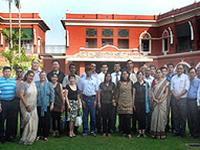
Participants of the Study Tour in Kolkata with staff and Board Members of the NGO, SCIR.
National police officers and National AIDS Programme heads from Cambodia, Maldives, Mongolia, Philippines, and Sri Lanka visited India last mnth to get a firsthand experience of law enforcement initiatives on interventions related to high risk populations.
Organised by the UNAIDS India office with support from the Regional Support Team of Asia-Pacific, the 16 participants visited and interacted with programme staff of police-initiated and supported projects in Kolkata and New Delhi. The purpose of the Study Tour was to learn the approaches of and lessons learned from law enforcement efforts for sex workers and injecting drug users and their vital role in creating a supportive environment for HIV interventions.
In Delhi, the participants visited Shakti Vahini, a non-governmental organization (NGO) working with sex workers on GB Road, one of Delhi’s oldest red light areas. Personal interactions with sex workers provided them with first-person stories of the realities of brothel-based sex work and the relationships the workers have built with the district police. The Tihar Prison, India’s largest prison, showcased the prison’s innovative and comprehensive programme for recovering injecting drug users, a model programme now being promoted in other prisons in India.
The Toll-free Hotline run by the Central Reserve Police Force (CRPF) - which has a national workforce of a million workers – was of great interest to the group. With the assistance of software developed especially for the project, the Hotline takes calls from police personnel from all parts of India on HIV, sexually transmitted infections, drug and substance abuse and provides addresses of counselling centres and welfare schemes of CRPF. The Helpline has responded to thousands of calls for information and for referrals to counselling services.
In West Bengal, the group travelled from Kolkata to Asansol, a large industrial town with a settlement of sex workers. The project DISHA Jana Kalyan Kendra began its work in 1995 with a collaboration with the district police force with the aim of improving the health and socio-economic conditions of sex workers in the town. In addition to providing health services, vocational and job skills training, and pre-school education for children of sex workers, DISHA has worked with the police in reducing criminality in the community.
In Kolkata, the Study Tour participants visited the NGO Society for Community Intervention and Research (SCIR) to observe their work with people who inject drugs (IDUs). The NGO works in the community of Tiljala, the largest slum settlement in Kolkata. It offers educational programmes for children, livelihood training for IDUs as well as an oral substitution treatment programme.
The projects covered in the Study Tour gave a novel perspective on the role of the police sector not only as law enforcers but also as community enablers. Given the legal and judicial frameworks in the countries represented by the participants, these innovations gave rise to challenges on how they may be replicated in their countries. The Study Tour, as a South-South learning opportunity, demonstrated encouraging prospects of police leadership to break new ground.

Feature Story
Global Fund approves US$2.4 billion in new grants
12 November 2009
12 November 2009 12 November 2009The Global Fund to Fight AIDS, Tuberculosis and Malaria’s Board of Directors has approved new grants with a two-year commitment of US$2.4 billion. The Global Fund Board concluded its 20th meeting in Addis Ababa, Ethiopia on 11 November. High on the agenda were discussions on the implications of the global financial crisis for a fully funded AIDS response.
The Global Fund Board also announced the launch its next round of grants in May 2010. This round of funding will be considered for approval at a Board meeting to be held some time between November 2010 and January 2011.
“We are seeing a tremendous demand for funding,” said Michel Kazatchkine, the Executive Director of the Global Fund. “Countries are showing that they are able to effectively turn large amounts of money from donors into prevention, care and treatment of AIDS, TB and malaria, which in turn will save millions of lives.”
Addressing the Global Fund Board earlier in the week UNAIDS Executive Director, Mr Michel Sidibé congratulated Dr Kazatchkine on the excellent progress made over the last year.
Mr Sidibé expressed concern that because overall resource demand is higher than anticipated in the funding scenario of the replenishment meeting in Berlin in 2007, the Global Fund risks facing a resource gap for the period 2009-2010. He reiterated his call to donor countries to ensure that the Global Fund is fully funded. He also called for appropriate prevention investments that match the nature of the epidemic, for example in Eastern Europe where HIV is mainly transmitted via injecting drug use.
Speaking on the potential impact of the financial crisis on the AIDS response, Mr Sidibé called for innovative approaches and the need to establish new partnerships in the AIDS response.
With its key approaches – country ownership, inclusiveness, accountability and performance-based funding – the Global Fund is setting the standard in development financing and is strongly aligned with aid effectiveness principles. Praising this approach, Mr Sidibé encouraged even greater engagement with implementing countries and communities in decision-making processes.
Mr Sidibé also committed to scaling up technical support from the UN system and that UNAIDS programme at the country and regional level would expand its support to the Global Fund.
A strengthened partnership at country level will lead to greater cohesiveness and sustainability of the response.
UNAIDS Executive Director Michel Sidibé
“A strengthened partnership at country level will lead to greater cohesiveness and sustainability of the response,” said Mr Sidibé.
The Global Fund Board also approved a new grant architecture to simplify grant management and reporting by countries and facilitate their strategic, long-term planning.
The Global Fund was created in 2002 with a mandate to dramatically increase resources to fight three of the world's most devastating diseases – HIV, TB and Malaria, and to direct resources to areas of greatest need. It has since approved a total funding of US$18.4 billion for 144 countries. It’s a global public/private partnership between governments, civil society, the private sector and affected communities the Global Fund represents a new approach to international health financing.
Global Fund approves US$2.4 billion in new grants
Feature stories:
UNAIDS reaffirms its partnership with Global Fund as board meeting concludes (07 May 2009)
UNAIDS partnership with the Global Fund to Fight AIDS, Tuberculosis and Malaria
Call for fully funded Global Fund to fight AIDS, Tuberculosis and Malaria (31 March 2009)
New tool distills guidance on writing strong Global Fund HIV proposals (02 February 2009)
Partners:
The Global Fund to Fight AIDS, Tuberculosis and Malaria
Press centre:
Press release: The Global Fund to Fight AIDS, Tuberculosis and Malaria (12 November 2009)
Related

Feature Story
Monitoring progress towards global HIV targets
11 November 2009
11 November 2009 11 November 2009In a supplement of the Journal of AIDS’ December issue published yesterday, UNAIDS explores some of the current challenges to monitoring the progress towards global HIV targets.
The supplement, called Progress Towards Global HIV Targets: Challenges in Monitoring National Indicators, explores thematic, technical analysis of data and key findings derived from the United Nations General Assembly Special Session on HIV/AIDS (UNGASS) reporting system.
The issue was guest co-edited by Dr Deborah Rugg, Chief Monitoring and Evaluation UNAIDS and covers issues such as human rights in the global response to HIV and estimating the level of HIV prevention coverage, as well as addressing the key question: Are we on course for reporting on the Millennium Development Goals in 2015?
In a time of ever more acute resource limitation, more and better studies are required that effectively evaluate whether programmes achieved their desired results, and whether those results lead to their intended outcomes.
Dr Deborah Rugg, Chief Monitoring and Evaluation UNAIDS
“In a time of ever more acute resource limitation, more and better studies are required that effectively evaluate whether programmes achieved their desired results, and whether those results lead to their intended outcomes,” said Dr Rugg.
The 2001 UNGASS Declaration set forth concrete, time-bound commitments to promote a comprehensive and effective global response to the epidemic. The UNAIDS Secretariat was subsequently given a mandate to develop an international monitoring system for national HIV responses in order to manage this reporting.
The resulting system has generated an unparalleled global body of evidence across the range of national HIV responses and key thematic areas.
The articles included in the supplement uses data and key findings derived from the UNGASS reporting system, combined with complimentary data from other sources, on the status of both the global HIV epidemic and the response.
Monitoring progress towards global HIV targets

Feature Story
New report calls for policy changes on HIV and disability
11 November 2009
11 November 2009 11 November 2009Participants at the International Policy Dialogue, held in Ottawa, Canada, March 2009
Credit: Health Canada
A new report by Health Canada’s International Affairs Directorate has called for a greater focus on rights of people with disabilities in HIV policy. The report makes recommendations for policy change and follows an International Policy Dialogue held between UNAIDS, Health Canada and the Public Health Agency of Canada in Ottawa in March 2009.
Titled “HIV/AIDS and Disability: Final Report of the 4th International Policy Dialogue”, it calls for the United Nations' Convention on the Rights of Persons with Disabilities (CRPD) to become a catalyst for change by shifting the disability discourse from charity-based or medical-based approaches to a rights-based approach. This approach views people with disabilities as active participants in society, ensuring their wellbeing rather than treating them as passive recipients of charitable goodwill.
The report recommends the involvement of stakeholders in helping CRPD become a tool for change. These stakeholders include WHO, UNICEF, UNAIDS, national governments and ministries and civil society organizations working in the areas of disability and HIV.
There is a double stigma experienced by people living with both HIV and disability. Much effort is required to overcome this, beginning with raising awareness and open communication. For example, in South Africa youth with disabilities are trained to provide HIV prevention and treatment information to their peers; in Kenya HIV screening information is provided to the deaf by the deaf; and Uganda has established mental health clinics for people living with HIV. The report suggests taking a lead from these programmes.
The International Policy Dialogue meeting was organized by UNAIDS, Health Canada and the Public Health Agency of Canada
Credit: Health Canada
It calls for service providers in the AIDS response to be sensitised on how to interact with people with disabilities and to establish mobile voluntary counselling and treatment services to increase access to people living with disabilities who are unable to reach them on their own.
The HIV and Disability report recognises the need for more education and awareness for children, youth and adults living with developmental disabilities, and also suggests working on providing information on sexual and mental to people with disabilities.
The report discusses challenges related to sustaining pilot projects, securing funds, sharing the results and benefits of HIV, AIDS and disability projects, and educating donor countries, governments and NGOs in the value of investing in this area.
UNAIDS, along with WHO and the United Nations Office of the High Commissioner for Human Rights, has collaborated on a policy brief exploring the links between HIV and disability and that also makes recommendations for policy change.
Apart from discussing the actions needed to increase the participation of persons with disabilities in the HIV response and to ensure they have access to HIV services, it also recommends for governments to incorporate persons with disabilities into their national HIV policies.
It also urges civil society to ensure campaigns to combat stigma and discrimination of people living with HIV are also accessible to persons with disabilities and advocates for the latter to be included in planning, implementation and evaluation of HIV programmes.
People with disability
Around 650 million people, or 10% of the world’s population, have a disability. Although people with disabilities are found within the populations at higher risk of exposure to HIV, not much attention has been paid in the past to the relationship between HIV and disability.
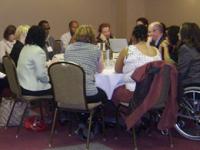
Participants in breakout groups at the International Policy Dialogue, held in Ottawa, Canada, March 2009
Credit: Health Canada
People with disabilities and people living with HIV shared their personal experiences during the International Policy Dialogue in March to give voice to both the challenges they face and the abilities they hold.
Persons with disabilities experience all of the risk factors associated with HIV, and are often at increased risk because of poverty, severely limited access to education and health care, lack of information and resources, lack of legal protection, increased risk of violence and rape, vulnerability to substance abuse, and stigma.
New report calls for policy changes on HIV and di
Cosponsors:
Partners:
UN Office of the High Commissioner for Human Rights
Health Canada
Public Health Agency of Canada
Feature stories:
Disability and HIV in Jamaica (08 September 2008)
External links:
Journal of the International AIDS Society - Thematic page on HIV and Disability
Publications:
Policy brief: Disability and HIV (pdf, 207 Kb)
HIV/AIDS and Disability: Final Report of the 4th International Policy Dialogue
Related

Feature Story
Violence against women and HIV
10 November 2009
10 November 2009 10 November 2009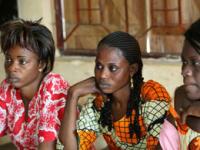
Women living with HIV are more likely to have experienced violence, and women who have experienced violence are more likely to have HIV infection. Credit: UNAIDS/P.Virot
Numerous studies from around the globe confirm the links between violence against women and HIV. These studies show that women living with HIV are more likely to have experienced violence, and that, women who have experienced violence are more likely to have HIV infection.
From 27-29 October the World Health Organization (WHO), on behalf of the UNAIDS family, convened a working group of experts and practitioners to review evidence around the links between violence against women and HIV, as well as programmatic interventions and strategies which address the intersections of violence and HIV. The aim of the meeting was to make policy and programmatic recommendations for national and international AIDS programmes as well as to develop an agenda for future programme development, evaluation and research efforts based on a review of evidence from different interventions.
The meeting was part of UNAIDS efforts to operationalize the Joint Action for Results: the UNAIDS Outcome Framework, which includes violence against women and girls as one of its nine priority areas.
Violence and HIV
According to a 2006 report by United Nations Secretary-General one out of every three women around the world has been beaten, coerced into sex, or otherwise abused in her lifetime, usually by someone known to her.
Long-term interventions which address structural factors, gender inequalities and harmful gender norms, are essential if one is to reduce violence against women and HIV.
Kristan Schoultz, Director, Global Coalition on Women and AIDS
Violence and the threat of violence dramatically increase the vulnerability of women and girls to HIV by making it difficult or impossible for women to abstain from sex, to get their partners to be faithful, or to use a condom. The risk of HIV transmission increases during violent or forced-sex situations as the abrasions caused through forced penetration can facilitate entry of the virus.
Violence, or fear of violence, also makes it difficult for women and girls to disclose their HIV status and access essential HIV prevention, care, and treatment services. Women may also avoid HIV testing due to fears of violence and abandonment in a resulting discovery of HIV-positive status.
As noted by Dr. Claudia Garcia-Moreno, from WHO’s Department of Reproductive Heatlh and Research and Coordinator of the WHO Multi-country Study on women's health and domestic violence, “Violence against women is a fundamental violation of human rights and is often fueled by longstanding social and cultural norms that reinforce its acceptability in society – by both men and women. But there are concrete steps we can take in the AIDS and development responses to address violence, thereby dramatically improving women’s health and quality of life”.
Behaviour and societal change
According to participants at the consultation, policies and programmes addressing gender inequality and gender-based violence will help achieve universal targets to HIV prevention, treatment and care. Investment in responses in these areas is an essential part of HIV programming.
“Long-term interventions which address structural factors, gender inequalities and harmful gender norms, are essential if one is to reduce violence against women and HIV,” said Kristan Schoultz, Director of the Global Coalition on Women and AIDS. “At the same time there is also a need to move forward urgently to achieve shorter-term gains such as enhanced voluntary counselling and testing services and the provision of comprehensive post-rape care that addresses the psychological and physical health needs of sexual violence survivors”.
Participants believe that a “mosaic” of action addressing both long-term and short-term needs related to violence and HIV has the potential to have an impact upon not only MDG 6 (HIV), but all the health MDGs, including reduction of maternal mortality and achievement of sexual and reproductive health and rights; in addition, this approach is at the heart of MDG 3 (gender equality and empowerment of women) and MDG1 (poverty reduction).
The outcomes and recommendations from the meeting will feed into ongoing national and global advocacy efforts such as those of the Global Coalition on Women and AIDS, the UN Secretary General's Campaign for the Elimination of Violence against Women, and the Africa-Wide Campaign for the elimination of Violence against Women. Recommendations will also assist national AIDS authorities to better address the intersections between HIV and violence in national programming.
Violence against women and HIV
Cosponsors:
Partners:
Global Coalition on Women and AIDS (GCWA)
Feature stories:
WHO report on the health of women: AIDS leading cause of death globally in women of reproductive age (09 November 2009)
Empowering women to protect themselves: Promoting the female condom in Zimbabwe (29 October 2009)
UNAIDS partners in new Clinton Global Initiative to address sexual violence against girls (25 September 2009)
New report shows Asian migrant women in the Arab states have heightened vulnerability to HIV (10 March 2009)
Commission on the Status of Women opens with call for action to achieve universal access and gender equality (02 March 2009)
Challenging violence against women a key task for newly launched Caribbean Coalition on Women, Girls and AIDS (06 March 2009)
Highlighting sexual violence on International Women’s Day (05 March 2009)
Publications:
Women and Health: Today’s Evidence, Tomorrow’s Agenda
UNAIDS Outcome framework 2009-11 (pdf, 396 Kb.)
2008 Delegates Guide to Women and AIDS: All Women, All Rights (pdf, 506 Kb.)
An Analysis of the Gender Policies of the Three Major AIDS Financing Institutions: The Global Fund to Fight AIDS, Tuberculosis and Malaria, the World Bank and the President’s Emergency Plan for AIDS Relief (pdf, 150 Kb.)
Joint action for results: UNAIDS outcome framework, 2009 – 2011 (pdf, 322 Kb.)

Feature Story
WHO report on the health of women: AIDS leading cause of death globally in women of reproductive age
09 November 2009
09 November 2009 09 November 2009
In a landmark report on the health of women and girls across the globe, the World Health Organization (WHO) states that AIDS-related illness is the leading cause of death and disease among women of reproductive age in low and middle income countries, particularly in Africa. Also, globally, unsafe sex is the single leading risk factor contributing to deaths among women of reproductive age. These findings support the contention in Women and Health: Today’s Evidence, Tomorrow’s Agenda that in a multiplicity of areas female health is neglected and must now be considered an urgent priority
The report maintains that women and girls are especially vulnerable to HIV infection due to a variety of biological and social factors. These include low socio-economic status that can limit choices and lead to high risk behaviours and norms and laws that subjugate women and which discourage them from seeking and obtaining the information they need to keep themselves safe. For example, globally only 38% of young women are able to describe the main ways to avoid infection and they are less likely to know that condoms can protect against HIV than young men. Data from 16 countries in sub-Saharan Africa from 2001-2007 also show that HIV prevalence is generally higher among adolescent girls aged 15-19 than their male counterparts. A significant cause of this is young girls partnering with older men who are more sexually experienced and more likely to be infected.
Violence against women
Violence against women is also a major cause of their increased vulnerability to HIV. It can make it difficult or impossible for them to control their sexual lives, abstain from sex or get their partners to use condoms. Violence, or the threat of it, can also result in women avoiding HIV prevention, treatment, care and support services.
We know that there is a strong relationship between violence against women and HIV. We need to help young people develop the skills for mutual consent in sex and marriage and put an end to violence and sexual coercion. This is key to preventing HIV and to achieving gender equality in all aspects of life.
Michel Sidibe, Executive Director of UNAIDS
For UNAIDS, this is a major area of concern and its Outcome Framework 2009-11 has stopping violence against women and girls as one of nine priority areas. According to Michel Sidibe, Executive Director of UNAIDS, “‘We know that there is a strong relationship between violence against women and HIV. We need to help young people develop the skills for mutual consent in sex and marriage and put an end to violence and sexual coercion. This is key to preventing HIV and to achieving gender equality in all aspects of life.”
Gender inequalities
Women and Health has an extremely broad scope and addresses a range of women’s health issues. The factors that come into play to increase women’s vulnerability to AIDS are also shown to profoundly affect women and girls’ general health and well-being. As the report contends, gender inequalities in the allocation of resources such as education, income, health care, nutrition and having a political voice are very much associated with poor health and reduced well-being.
“Despite considerable progress over the past two decades, societies are still failing women at key moments in their lives,” says Dr Margaret Chan, WHO Director-General, in the foreword to Women and Health. “These failures are most acute in poor countries, and among the poorest women in all countries. Not everyone has benefited equally from recent progress and too many girls and women are still unable to reach their full potential because of persistent health, social and gender inequalities and health system inadequacies.”
Key stages relevant for health: early childhood, adolescence, adulthood and older age
The report explores the lives of women and girls through key stages relevant for health: early childhood, adolescence, adulthood and older age, and shows that women face “widespread and persistent inequities” during each of these stages. It not only highlights women’s health needs- and how they are not being currently met in terms of HIV and other areas- but also the valuable contribution that they make to the health sector and society in general.
By using today’s evidence, sharing what is currently known about the health of women from all regions and throughout their lives, the report attempts to set out tomorrow’s agenda, a key element of which is championing reforms to enable women to not only be seen in their sexual and reproductive capacity, but to become active agents in health-care provision, playing a central role in the design, management and delivery of health services.
Women and Health draws attention to four areas where policy action could make a real difference to women’s health: building strong leadership and a coherent institutional response coalescing around a clear agenda; making health systems work for women; leveraging changes in public policy to encourage fundamental social change (through, for instance, targeted action to help girls enrol in school); and finally, building the knowledge base and monitoring progress.
WHO hopes that by reviewing the available data and charting a cogent way forward that the health of women and girls, and society as a whole, can be ameliorated. As the report has it, “Improve women’s health, improve the world.”
WHO report on the health of women: AIDS leading c
Key populations:
Cosponsors:
Partners:
The Global Coalition on Women and AIDS (GCWA)
Press centre:
WHO calls for action beyond the health sector to improve the health of girls and women (09 November 2009)
Feature stories:
Empowering women to protect themselves: Promoting the female condom in Zimbabwe (29 October 2009)
UNAIDS partners in new Clinton Global Initiative to address sexual violence against girls (25 September 2009)
New report shows Asian migrant women in the Arab states have heightened vulnerability to HIV (10 March 2009)
Commission on the Status of Women opens with call for action to achieve universal access and gender equality (02 March 2009)
Challenging violence against women a key task for newly launched Caribbean Coalition on Women, Girls and AIDS (06 March 2009)
Highlighting sexual violence on International Women’s Day (05 March 2009)
Publications:
Women and Health: Today’s Evidence, Tomorrow’s Agenda
UNAIDS Outcome framework 2009-11 (pdf, 396 Kb.)
2008 Delegates Guide to Women and AIDS: All Women, All Rights (pdf, 506 Kb.)
An Analysis of the Gender Policies of the Three Major AIDS Financing Institutions: The Global Fund to Fight AIDS, Tuberculosis and Malaria, the World Bank and the President’s Emergency Plan for AIDS Relief (pdf, 150 Kb.)

Feature Story
UNAIDS and Economic Commission for Africa discuss innovative financing for health in Africa
09 November 2009
09 November 2009 09 November 2009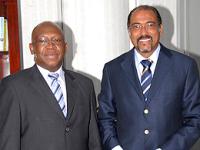 (from right) Executive Secretary of the UN Economic Commission for Africa Mr Abdoulei Janneh and Executive Director of UNAIDS Michel Sidibé, 9 November 2009.
(from right) Executive Secretary of the UN Economic Commission for Africa Mr Abdoulei Janneh and Executive Director of UNAIDS Michel Sidibé, 9 November 2009. Credit: UNAIDS
The Executive Director of UNAIDS Michel Sidibé met with the Executive Secretary of the Economic Commission for Africa (ECA) Mr Abdoulei Janneh earlier today in Addis Ababa, Ethiopia.
They held broad-ranging discussions on the relationship between health and development and the need to find innovative ways to generate financial resources to fund future HIV treatment for people in need. The importance of resource monitoring and evaluation of results for the Millennium Development Goals was also underlined.
Mr Abdoulei Janneh also updated Mr Sidibé on the Coalition for Dialogue in Africa (CoDA) which was launched earlier this year as a joint venture between the African Development Bank and the ECA to stimulate discussions on African socioeconomic issues and explore new ways for Africa development.

(from left) Executive Director of UNAIDS Michel Sidibé and the Executive Secretary of the UN Economic Commission for Africa Mr Abdoulei Janneh held discussions on health financing, 9 November 2009.
Credit: UNAIDS
The CoDA initial advisory board includes Dr Frene Ginwala, Former Speaker of the National Assembly of South Africa; Mr Mo Ibrahim, Chair, Mo Ibrahim Foundation; Dr. Spciosa Wandira Kazibwe, former Vice President of the Republic of Uganda; and The Right Honourable, Mr. Paul Martin, former Prime Minister of Canada.
While in Addis this week Mr Sidibé is attending the board meeting of the Global fund to Fight AIDS, TB and Malaria.

